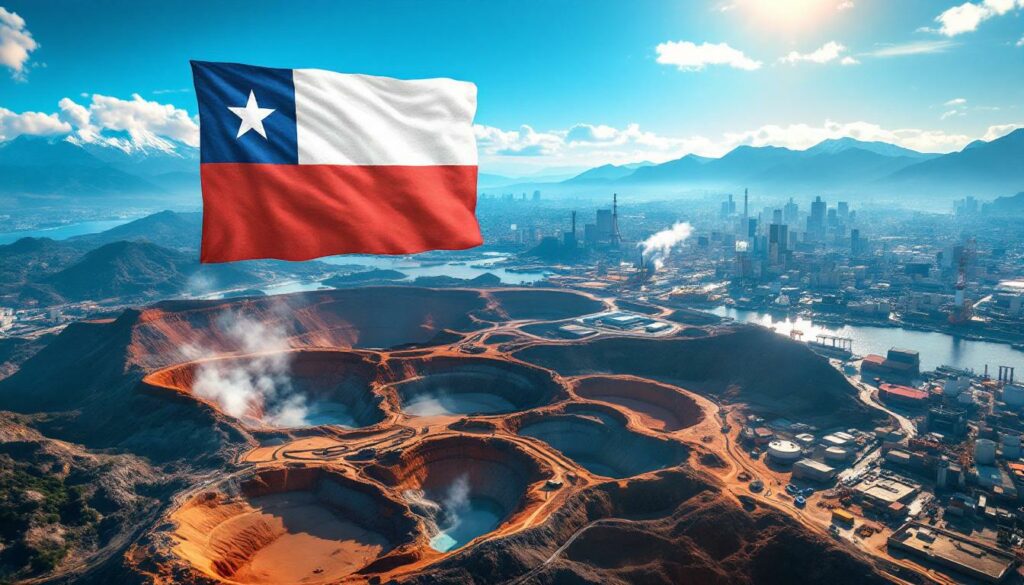Chile's Economy Declines on Biggest Mining Plunge Since 2017
Chile's economy unexpectedly contracted for the second consecutive month in June 2025, primarily due to a significant downturn in the mining sector. The Imacec index, Chile's monthly economic activity indicator serving as a GDP proxy, declined by 0.4% from May, contradicting economists' expectations of a 0.3% increase. Despite this monthly setback, the index still gained 3.1% compared to June 2024, highlighting the complexity of Chile's current economic situation.
This economic contraction has raised concerns about the country's overall economic health, with the mining sector's performance overshadowing positive developments in other areas. As Chile navigates this challenging period, both domestic and international factors continue to shape its economic trajectory.
How Severe Is Chile's Mining Sector Decline?
The 9.3% Mining Plunge
The mining sector experienced a dramatic 9.3% drop in June 2025, marking the most significant monthly decline since 2017. This substantial contraction in one of Chile's most crucial economic sectors has had ripple effects throughout the national economy, offsetting gains in other industries.
Chile, as the world's largest copper producer, has historically experienced volatility in its mining sector, but the current decline represents an unusually sharp downturn. The severity of this contraction is particularly noteworthy given the sector's outsized influence on Chile's export earnings and overall GDP.
"This is a weak end to the quarter, but largely due to mining volatility," noted Andres Abadia, chief Latin America economist at Pantheon Macroeconomics, in his assessment of the situation. His analysis suggests that while concerning, the decline might represent a temporary fluctuation rather than a long-term trend.
Impact on Economic Activity Index
The unexpected mining sector collapse contributed significantly to the 0.4% decline in Chile's Imacec index in June, marking the second consecutive monthly decline in overall economic activity. This consecutive contraction has raised questions about whether Chile might be entering a more challenging economic period.
The mining sector's outsized influence on Chile's economic performance is evident in how dramatically it affected the overall economic indicators despite positive performance in other sectors. Copper alone accounts for approximately 50% of Chile's export earnings and roughly 10-15% of GDP when including related services and industries.
Which Economic Sectors Are Performing Well Despite Mining Troubles?
Industrial Growth and Commercial Activity
While mining struggled, other sectors showed remarkable resilience in June 2025:
- Industrial production increased by 2.2%, demonstrating continued manufacturing strength
- Commercial activity rose by 0.7%, indicating steady consumer spending
- Service sectors expanded by 0.4%, showing growth in Chile's increasingly diversified economy
These positive indicators across non-mining sectors suggest that Chile's economic diversification efforts are bearing fruit, even as its traditional economic pillar faces challenges.
Underlying Economic Momentum
Despite the headline decline, economic analysts note that underlying momentum remains intact in non-mining sectors. According to Chile's central bank, private consumption and investment continued to grow in recent months, providing a crucial counterbalance to mining sector weakness.
Andres Abadia pointed out that consumption is "being supported by factors including rising wages, slowing inflation and improving credit conditions." This resilience in domestic consumption is particularly important as Chile works to reduce its historical dependence on mining exports.
What Factors Are Supporting Chile's Economic Recovery?
Monetary Policy Adjustments
The Chilean central bank lowered interest rates to 4.75% in its first reduction of 2025, signaling confidence in the country's inflation outlook and supporting economic recovery efforts. This monetary easing is expected to stimulate investment and consumption across sectors.
The rate cut reflects the central bank's balancing act between supporting economic growth and maintaining price stability. With inflation approaching target levels, policymakers have gained flexibility to address growth concerns through more accommodative monetary policy.
Improving Consumer Conditions
Several factors are bolstering consumption despite mining sector challenges:
- Rising wages across non-mining sectors are increasing household purchasing power
- Slowing inflation rates approaching the central bank's target are preserving real income
- Improving credit conditions for businesses and consumers are facilitating spending
- Lower borrowing costs are stimulating investment in productive capacity
Finance Minister Mario Marcel has expressed optimism that "the labor market will mend as the economic recovery gains steam," suggesting government confidence that current challenges are temporary rather than structural.
How Is Chile's Political Landscape Affecting Economic Outlook?
Presidential Election Implications
The upcoming November 2025 presidential election is significantly influencing economic expectations in Chile:
- Right-wing candidate José Antonio Kast has emerged as the frontrunner in recent polls
- Kast has proposed reducing corporate tax rates from 27% to 20%
- His platform includes cutting public spending by $6 billion within 18 months
- Business-friendly government expectations are reviving investment confidence
These potential policy shifts have already begun affecting business sentiment and investment decisions, with many companies adopting a "wait-and-see" approach before committing to major expansions or projects.
Election Timeline and Economic Uncertainty
The presidential election schedule includes:
- First round voting on November 16, 2025
- Likely runoff election on December 14, 2025
- Period of economic policy uncertainty until the new administration takes office
This political timeline creates a window of uncertainty that may temporarily dampen investment, particularly in sectors sensitive to regulatory changes or government policy. However, expectations of market-friendly policies following the election have provided a positive counterbalance to current economic challenges.
What International Factors Are Affecting Chile's Mining Economy?
US Trade Policy Impact
Recent international developments have provided some positive news for Chile's mining sector:
- US President Trump spared refined copper from a proposed 50% tariff
- Chilean copper cathodes will continue to enter the US market tariff-free
- This policy decision benefits Chile's top export product
- The US remains Chile's second-largest trading partner
Finance Minister Mario Marcel confirmed that Chilean copper shipments will continue to enter the world's largest economy without tariffs, providing crucial stability for the country's primary export sector during a challenging period. Understanding the trade war market impact is essential for forecasting Chile's economic recovery.
Global Copper Market Dynamics
Chile's position as the world's largest copper producer makes it particularly vulnerable to:
- International copper price fluctuations driven by global demand shifts
- Supply chain disruptions affecting production and distribution
- Changing demand patterns in major markets like China, which consumes approximately half of global copper production
- Trade policy decisions by major importing nations that can dramatically affect market access
These international factors create a complex environment for Chile's mining sector, with forces beyond domestic control often determining the industry's performance and profitability. Recent copper price insights suggest potential recovery in the medium term, which could benefit Chile's economy significantly.
What Are the Labor Market Conditions in Chile?
Employment Challenges
Despite some economic bright spots, Chile's labor market continues to face difficulties:
- Job creation remains minimal across sectors, limiting household income growth
- Unemployment rates remain elevated compared to pre-pandemic levels
- Mining sector employment is particularly vulnerable during production downturns
- Skills mismatches between job seekers and emerging sectors create structural challenges
Finance Minister Mario Marcel has indicated the labor market will improve as economic recovery gains momentum, but the current situation remains challenging for many Chilean workers and job seekers.
Sectoral Employment Trends
Employment trends vary significantly across Chile's economic sectors:
- Mining employment has declined alongside production decreases
- Service sector jobs continue to grow, particularly in technology and tourism
- Manufacturing employment has stabilized but shows limited growth
- Public sector hiring has slowed under current fiscal consolidation efforts
These divergent trends reflect Chile's ongoing economic transformation and the challenges of transitioning workers between declining and emerging sectors. Understanding broader mining sector trends is crucial for projecting future employment opportunities.
How Do Chile's Current Economic Indicators Compare Historically?
Year-Over-Year Performance
Despite the monthly decline, Chile's economy showed some positive signs when viewed from a longer perspective:
- The Imacec index gained 3.1% compared to June 2024
- This annual growth occurred despite the significant mining sector contraction
- Non-mining sectors demonstrated stronger year-over-year performance
- Consumer spending has recovered to above pre-pandemic levels in most categories
These comparative indicators suggest that despite current challenges, Chile's economy maintains positive momentum when viewed over a longer timeframe.
Historical Mining Volatility
The mining sector's 9.3% monthly decline represents:
- The most severe monthly contraction since similar disruptions in 2017
- Part of a historical pattern of volatility in Chile's mining production
- A significant deviation from recent years' more stable performance
- A reminder of the risks associated with commodity dependence
This historical context helps frame the current decline as severe but not unprecedented, suggesting the potential for recovery based on previous patterns.
What Are The Prospects For Chile's Economic Recovery?
Short-Term Outlook
Economic analysts suggest the recent decline represents a temporary setback rather than a fundamental shift:
- The economic contraction is largely attributed to mining volatility rather than broader weakness
- Underlying economic momentum remains intact in non-mining sectors
- Consumption continues to grow despite mining challenges
- Recent central bank rate cuts are expected to stimulate economic activity
Andres Abadia of Pantheon Macroeconomics emphasizes that "underlying momentum is intact" despite the headline numbers, suggesting confidence in Chile's recovery prospects.
Structural Economic Factors
Several structural elements will influence Chile's economic trajectory:
- Mining sector's continued dominance in export earnings creates ongoing vulnerability
- Diversification efforts across other economic sectors are showing promising results
- Political transition following the upcoming presidential election may reshape economic policy
- International trade dynamics, particularly regarding copper exports, remain crucial
Economic Perspective:
Chile's economic resilience will depend largely on its ability to balance traditional mining strength with developing new growth engines across manufacturing, services, and technology sectors.
Understanding effective copper investment strategies will be crucial for both domestic and international investors looking to capitalize on potential sector recovery.
FAQ About Chile's Economic Situation
Why is mining so important to Chile's economy?
Mining, particularly copper production, represents Chile's largest export sector and a significant contributor to GDP. The country is the world's largest copper producer, with the metal accounting for approximately 50% of export earnings and about 10-15% of GDP when including related services and industries.
Chile produces approximately 28% of the world's copper, making it an essential player in global supply chains for electronics, construction, and renewable energy technologies. This concentration creates both economic strength and vulnerability to international market fluctuations.
How does copper price volatility affect Chile's economic stability?
As Chile's primary export, copper price fluctuations directly impact government revenues, investment levels, and overall economic performance. When copper prices decline, export earnings decrease, potentially leading to:
- Budget constraints for government programs
- Currency depreciation affecting import costs
- Reduced economic growth as mining investment declines
- Lower tax revenues from mining companies
- Negative impacts on employment in mining regions
These effects highlight the importance of economic diversification efforts to reduce Chile's vulnerability to commodity price cycles.
What other industries is Chile developing to reduce mining dependence?
Chile has been working to diversify its economy through developing sectors such as:
- Renewable energy (particularly solar and wind, leveraging Chile's exceptional natural resources)
- Agriculture and food processing (including wine production and fruit exports)
- Tourism (highlighting Chile's diverse landscapes from Patagonia to the Atacama Desert)
- Information technology and services (developing Santiago as a regional tech hub)
- Manufacturing (including automotive parts and specialized equipment)
These diversification efforts aim to create more stable, sustainable economic growth less dependent on commodity price cycles.
How might the upcoming presidential election affect Chile's mining sector?
The election outcome will determine mining policy direction, including:
- Taxation levels for mining companies, with Kast proposing corporate tax reductions
- Environmental regulations affecting operations and new project approvals
- Investment incentives for new mining projects and expansion of existing operations
- Approach to state-owned mining company Codelco's role in the national economy
- Relationship with international mining corporations seeking to develop Chilean resources
These policy choices will shape not only the mining sector's future but also Chile's broader economic development path and environmental sustainability. Additionally, the global tariff effects from various countries will continue to influence Chile's trade relationships.
Further Exploration:
Readers interested in learning more about Chile's economic challenges can also explore related educational content available at Bloomberg's analysis of Chile's mining sector and the World Bank's overview of Chile's economy, which offers comprehensive insights into the country's development challenges.
Looking to Invest in The Next Major Mining Discovery?
Discover significant ASX mineral announcements in real-time with Discovery Alert's proprietary Discovery IQ model, transforming complex mineral data into actionable investment insights. Understand why major mineral discoveries can lead to substantial market returns by exploring Discovery Alert's dedicated discoveries page and begin your 30-day free trial today to position yourself ahead of the market.




